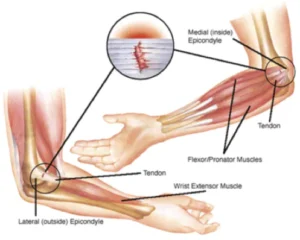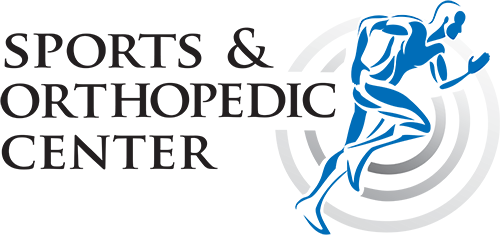The medical condition of elbow tendonitis goes by the more common name of golfer’s elbow, receiving its name from the sport that commonly produces this injury due to the repetitive movements made by those who golf.

This condition can cause pain, inflammation, and tenderness to the muscles on the inside of the elbow and forearm. Golfer’s elbow develops when these muscles are overused or from general wear and tear when grasping and flexing the wrist, two actions used when golfing.
4 Physical Therapy Exercises for Golfer’s Elbow
Physical therapy for golfer’s elbow has the ulterior motive of relieving pain, increasing blood flow, and reducing inflammation, as well as strengthening and stretching the affected muscles. The following four exercises effectively target the muscles affected by golfer’s elbow.
To get the best result, perform these exercises twice a day, but always be gentle and avoid forcing the movements. It’s also best to perform these exercises before and after doing anything that will trigger your golfer’s elbow. If these exercises cause your pain to worsen, stop doing them and allow your body to rest completely.
-
Isometric Wrist Extension
While sitting, place your injured forearm on a table or other flat surface with the palm facing down. Place the opposite hand on the back of the affected hand. Then, press down with your opposite hand (creating resistance) while pressing up with your affected hand.
Continue this action for 10 seconds, gradually increasing how much your opposite hand pushes down. Release and repeat for 15 reps in total.
-
Isometric Wrist Flexion
This exercise is very similar to the isometric wrist extension, but instead of facing your affected palm down, you will have it facing up while the forearm rests on the flat surface. Place the opposite hand into the affected hand and push down with it as you press up with your affected hand.
Continue for 10 seconds, gradually increasing resistance. Release and then repeat for 15 reps in total.
-
Wrist Curls
Place your affected forearm on a flat surface with your hand hanging over the edge and your palm facing up. Holding a 1-2 lb weight in your affected hand, slowly raise and lower the weight while keeping your forearm on the table. Repeat this exercise 8-12 times. Then, repeat this exercise with your hand facing down.
-
Wrist Flexor Stretch
Extend your affected arm in front of you with your fingers pointing up. Use your opposite hand to gently push your fingers and palm back toward your body until you feel a mild to moderate stretch in the forearm. Hold the stretch for at least 15 to 30 seconds, and then repeat 2 to 4 times.
Now, point the fingers of the affected hand down and repeat the exercise.
How Golfer’s Elbow Affects the Shoulder

Completing these exercises and stretches regularly will help to ease the pain of your golfer’s elbow while also improving strength and flexibility, preventing future injury.
Golfer’s elbow pain that is left untreated can spread to the shoulder, or shoulder pain can develop as your body overcompensates for the elbow’s lack of movement and strength. In these cases, shoulder orthopedics are needed to help treat the pain and strain experienced in the shoulder.
If you are still experiencing pain in your forearm after trying the above exercises, or if your shoulder has become affected, reach out to an orthopedic surgeon for information on how to best manage and monitor your pain.


